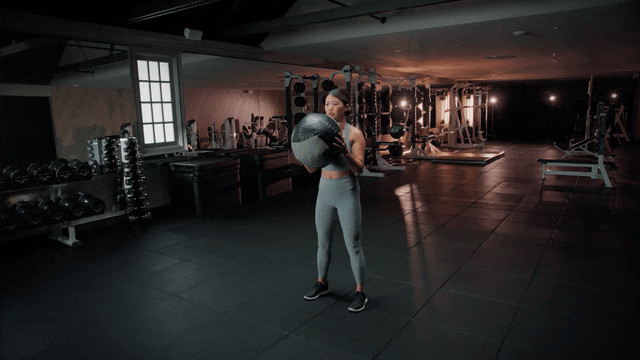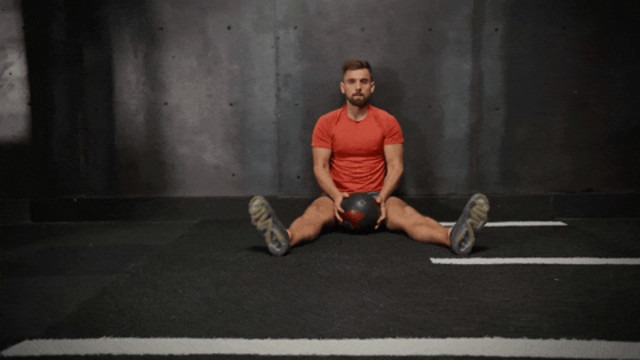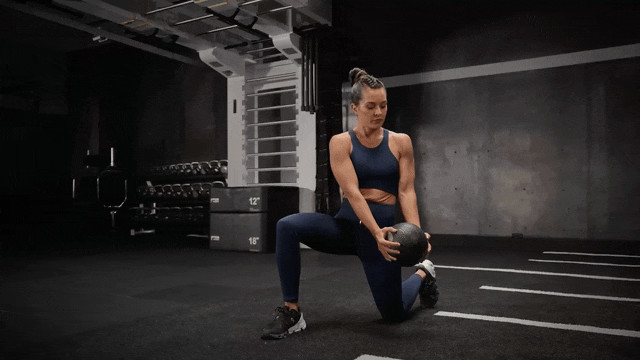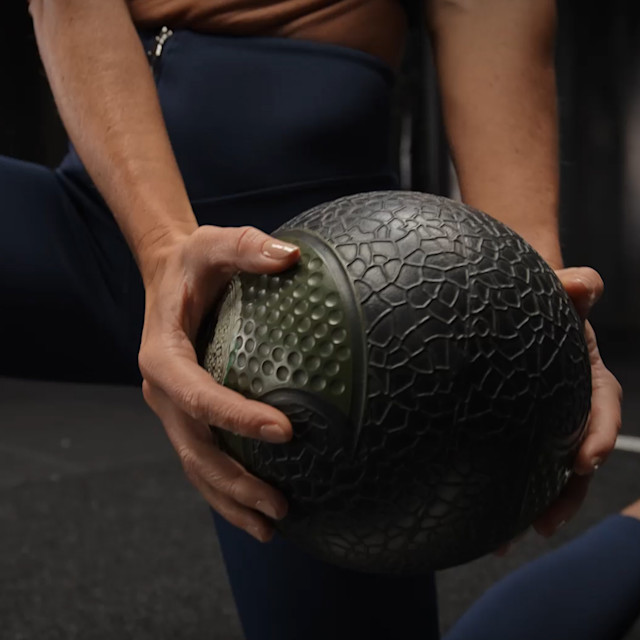Put the lightweight tool to good use on your next power training day.
Do More With is a series highlighting equipment around the Club that can help you reach your fitness goals. In this installment, we highlight the medicine ball, available on the Club floor.
When it comes to weight selection, members often have the mentality of “the heavier, the better.” It’s a beneficial perspective if your goal is to build pure strength. But sometimes, opting for a lighter load sets you up for the most success — and that’s the case with medicine balls.
An underappreciated piece of equipment, a medicine ball is essentially a loaded ball constructed either with a soft and squishy or hard, basketball-like exterior. They usually weigh between two and 30 pounds — which is why I occasionally hear my high-performing clients say they “feel too light.”
But, in my opinion, that small load is the tool’s main benefit. Here’s why.

Why Train with the Medicine Ball
Unlike dumbbells or kettlebells, med balls are designed to be tossed around; you can slam the soft versions to the ground, throw the hard-shelled, bouncy ones against a wall, or lob either style to a workout buddy without worrying about breaking the tool or, worse, hurting yourself. That nearly unbreakable feature, combined with their lighter load, is also what makes them ideal for power training.
Though it’s often associated with athletes, everyone needs to work on their power — the ability to produce as much force as possible as quickly as possible. Specifically, power training targets your fast-twitch muscle fibers, the type of muscle fibers that contract quickly — allowing you to have explosiveness — but tire rapidly.
RELATED: How to Train Fast-Twitch Muscle Fibers
These fibers are used for fast, short-term actions, and you need them trained and ready to go if you want to quickly step one leg out to the side and catch your balance when the subway suddenly lurches forward. You also need power to effectively throw a baseball with your kids. Not to mention, it’s one of the first elements of fitness that you lose with age, and research shows declining power (as well as other factors like muscle mass and strength) contributes to a stronger fear of falling.
Power training aside, light medicine balls are also useful as counterweights when you’re learning a single-leg exercise. Say you’re perfecting a single-leg deadlift. You can hold a med ball in the hand opposite of the working leg to help prevent your hips from opening up to the side. You're not looking to add resistance — you're just looking at a little bit of weight to better align the body and instill proper technique. Or, to challenge stability, you can place one or both hands on top of a med ball during a round of push-ups or planks.
How to Use the Medicine Ball

When power training, program your medicine ball moves at the top of your workout. The exercises place high demands on your muscles, so you don’t want to head into that part of your workout already feeling fatigued. On the same token, you’ll do only a handful of reps per set and allow yourself enough time to fully recover between rounds. Ideally, if you’re doing three sets of five reps, your final rep should feel as explosive as your very first. You shouldn’t feel smashed after you finish.
I love using the medicine ball for a combination of linear and lateral exercises. For the former, you can do a medicine ball chest pass, tossing the hard-shelled ball straight into a wall from your chest and catching it as it bounces back toward you. If you have adequate shoulder mobility, try an overhead slam to the ground or throw into the wall. Just stick with six pounds or lighter; the move opens up the shoulders and stretches out the fascia as you pull overhead, and too much weight can increase the risk of overstretching.

To work on side-to-side movement, you could do a wood chop, a side toss, or a shot put throw, a combo of a rotational side toss and a chest pass, where the ball starts racked on your shoulder. It’s almost like you’re serving the med ball into the wall volleyball-style. If you have a Club partner who has a similar fitness level, you could do med ball workouts together, tossing the equipment back and forth.
RELATED: How Power Impacts Longevity
Any time you’re prioritizing power, I recommend choosing a six- to eight-pound med ball, 10 pounds max. This is a scenario where you're going to get more benefit by taking some of the weight off. When you're doing resistance-based power training, you generally don't want to be lifting — regardless of the exercise — more than 10 percent of your body weight. That way, you get a little bit of push against some resistance but you’re able to be as explosive as possible.
In order to generate as much power as you can, you’ll need to drive the movement with your hips. Keep your arms elastic, and let the force transfer from your hips through your upper body; you’ll complete the exercise with greater speed than if you were to muscle through it. The easiest way to tell how you’re producing the force is by listening: When the ball hits, say, the wall, you'll hear a “snap” — like the crack of a whip — if your hips are driving. If it’s just your upper body, it’ll sound flat. That difference in noise can also be a sign to use a lighter med ball.
Rather than amping up the weight, progress your workouts by changing your position and adding a bit more dynamic movement. For a chest pass, you might transition from a kneeling position, which more thoroughly isolates the upper body, to a half-kneeling position. Then, you can take it to standing and, ultimately, a split stance. Once you master that, you can take a quick step forward before throwing the ball. Then challenge yourself with a shuffle step, shifting your weight from your front foot to your back foot before throwing the ball.
Regardless of the exercise or difficulty level, your focus should be on your speed, so use a med ball that’s light enough to achieve that. As long as you feel just as explosive and fast on your last rep as you do on your first rep, you're in a good spot.
Jenna DeAngelis is a COACH X at Equinox Hudson Yards, which she helped open in 2019. Her approach to fitness follows a structured system that allows you to move from mastering fundamental movement skills (motor control) to achieving elite levels of performance by addings strength, speed, and power on top of those solid fundamentals. Jenna is a lifelong athlete who is an NSCA-certified strength and conditioning specialist, ACE-certified personal trainer, and certified functional strength coach (level 2). She holds additional certifications from Precision Nutrition, U.S. Soccer, and U.S.A. Swimming.
